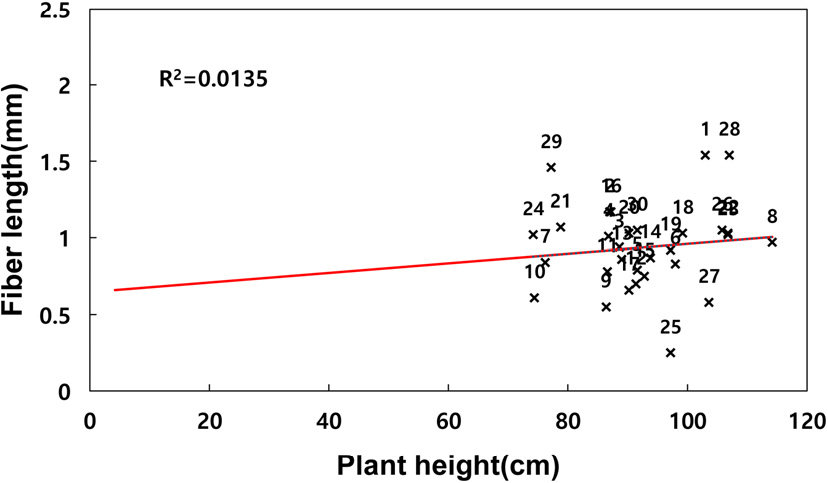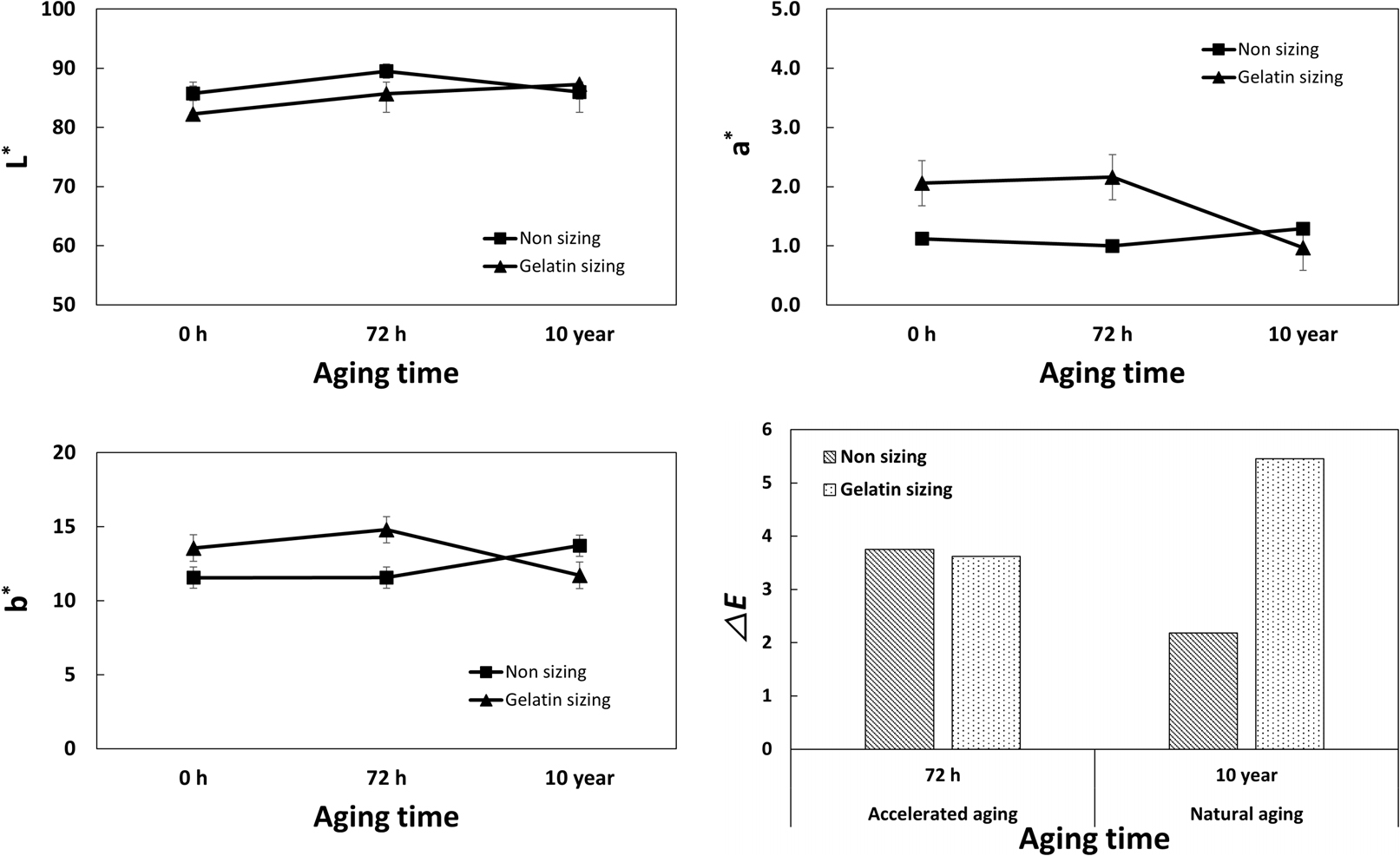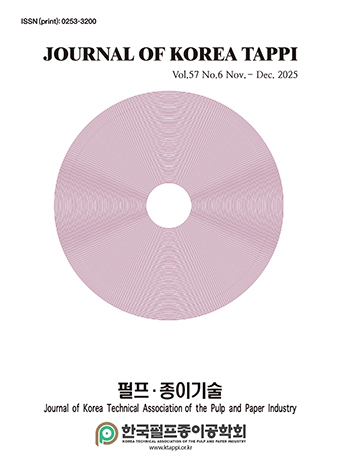-
Original Paper

- Effect of Carboxymethylation Pretreatment and Mechanical Fibrillation on Cellulose Nanofiber Dimensions
- Woo-Yong Song, Soo-Jeong Shin, Rahmini Rahmini
- Cellulose nanofibers (CNFs) are suitable for numerous industrial applications owing to their diverse propertheir potential as alternatives to petroleum-based products, their widespread …
- Cellulose nanofibers (CNFs) are suitable for numerous industrial applications owing to their diverse propertheir potential as alternatives to petroleum-based products, their widespread adoption is hindered by the challenge of tailoring their specific properties. To address this, this study was conducted to investigate how carboxymethylation pretreatment and mechanical fibrillation influence CNF morphology. To do this, the CNF degree of substitution (DS) during carboxymethylation was controlled from 0.1 to 0.6, after which its effects on CNF dimensions were analyzed by proton nuclear magnetic resonance spectroscopy and transmicroscopy. The results revealed that the CNF width decreased progressively as the DS was increased, with the length decreasing significantly at DS ≥ 0.5, which was attributed to enhanced anionic repulsion. Notably, a 0.2 DS only caused a decrease in the width, whereas a DS of 0.4 marked a transition where both dimensions were affected. Notably, at a DS of 0.6, the width and length of CNFs decreased substantially. Overall, these findings highlight the critical roles of DS and mechanical fibrillation in tailoring CNF morphology for specific applications. - COLLAPSE
-
Original Paper

-
Characterization of Cellulose Nanofiber Made from Red Algae Bleached Pulp Using Microgrinder
마이크로 그라인더로 제조된 홍조류 펄프 기반 셀룰로오스 나노섬유의 물성 평가
-
Ji Hyun Tak, Min Seo Kim, Ji Young Lee
탁지현, 김민서, 이지영
- This study investigated the feasibility of using red algae bleached pulp (RaBP) as a raw material for manunanofibers (CNFs) via mechanical treatment. …
- This study investigated the feasibility of using red algae bleached pulp (RaBP) as a raw material for manunanofibers (CNFs) via mechanical treatment. Hardwood bleached kraft pulp (HwBKP) and softwood bleached kraft pulp were used as controls. The physical properties of each pulp were assessed through morphological analysis, fiber length and width measurements, initial freeness, and degree of polyAmong the pulps characterized, RaBP exhibited the shortest fiber length and smallest width, along with a high initial freeness of 93 mL Canadian Standard Freeness (CSF), eliminating the need for beating or refining before CNF production. CNFs were prepared from RaBP and HwBKP using a microgrinder, and the characteristics of the resulting CNFs—referred to as RaCNFs and HwCNFs, respectively—were compared. As the number of grinding passes increased from 1 to 5, the particlesize and fiber width of RaCNFs and HwCNFs decreased, while their low-shear viscosity increased. RaCNFs exhibited smaller fiber dimensions but lower low-shear viscosity than HwCNFs, a difference attributed to the lower DP of RaBP. RaCNFs and HwCNFs exhibited negative zeta potentials, indicating stable dispersion. Overall, RaBP is a promising and efficient raw material for CNF production. - COLLAPSE
-
Characterization of Cellulose Nanofiber Made from Red Algae Bleached Pulp Using Microgrinder
-
Original Paper

-
Absorption Properties of pH-Responsive Carboxymethyl Cellulose Hydrogels Crosslinked with Epichlorohydrin and Citric Acid
에피클로로히드린과 시트르산으로 가교된 pH 감응성 카르복시메틸셀룰로오스 하이드로겔의 흡수 특성
-
Dohyeon Heo, Byoung-Uk Cho
허도현, 조병욱
- In this study, pH-responsive hydrogels were prepared from carboxymethyl cellulose (CMC) using epichloroor citric acid (CA) as crosslinkers to compare their swelling …
- In this study, pH-responsive hydrogels were prepared from carboxymethyl cellulose (CMC) using epichloroor citric acid (CA) as crosslinkers to compare their swelling and water-retention properties. CMC solutions containing varying concentrations of either crosslinker (0–1.5% (w/w)) were oven-dried to form their corresponding films, which were used to prepare the hydrogels. As observed, all solutions exhibehaviors, with viscosity increasing more significantly for the ECH-containing solution than for the CA-containing one. Fourier-transform infrared analysis confirmed the formation of an ether bond between the ECH and CMC hydroxyl groups and an ester bond between the CA carboxyl groups and CMC hydroxyl groups. The zeta potential for all prepared hydrogels shifted from near neutral at pH 3 to strongly negative at pH 11. Concurrently, the swelling capacity decreased sharply at a crosslinker concentration of more than 0.5%, while the centrifuge retention capacity (CRC) increased. The ECH-crosslinked hydrogels exhibited slightly lower swelling but higher CRC compared with the CA-crosslinked ones. These results indicate that the pH-responsive performance of CMC-based hydrogels can be tailored for smart-absorbent applications by adjusting the crosslinker type and concentration. - COLLAPSE
-
Absorption Properties of pH-Responsive Carboxymethyl Cellulose Hydrogels Crosslinked with Epichlorohydrin and Citric Acid
-
Original Paper

-
Anatomical and Chemical Characteristics of Rice Straw from Native Rice Varieties for Reproduction of Gojeong-ji
고정지 복원을 위한 토종벼 품종별 볏짚의 해부학 및 화학적 특성
-
Chang-Owan Park, Tae-Ho Choi
박창완, 최태호
- Gojeong-ji is a traditional Korean paper made by mixing mulberry bast fibers with rice straw or oat straw fibers. A scientific approach …
- Gojeong-ji is a traditional Korean paper made by mixing mulberry bast fibers with rice straw or oat straw fibers. A scientific approach is needed to identify native rice varieties whose straw is suitable as a raw mateGojeong-ji. A total of 30 Korean varieties were examined by separating the rice straw into four main parts: joints, stems, ear stalks, and leaf sheaths. Morphological and anatomical analyses included measurefiber length, fiber width, lumen diameter, aspect ratio, Runkel ratio, and flexibility coefficient. Chemical analyses determined the ash, holocellulose, lignin contents, and 1% NaOH extractives. The straw height ranged from 74.2 to 114.2 cm. The fiber length was longest in the following order: leaf sheath, ear stalk, stem, and node. Fiber length and plant height were significantly correlated. Fibers were widest in the nodes, with no marked differences among the stems, leaf sheath, and ear stalk. The nodes exhibited the widest cell lumen, and the lumen width decreased in the order of stems, leaf sheath, and ear stalk. When comparing the Runkel ratio, flexibility coefficient, and aspect ratio, the aspect ratio was found to have a greater effect on papermaking suitability than the other two parameters. The chemical composition of the 1% NaOH extracthe straw from the stem ranged from 26.8 to 43.1% (average 38.9%), holocellulose from 32.8 to 72.2% (average 50.5%), lignin from 9.3 to 17.2% (average 13.7%), and ash from 4.19 to 37.5% (average 19.9%). Based on these results, ten indigenous rice varieties with properties suitable for Gojeong-ji proselected. They included ‘Jeoktomi-green (No. 26),’ ‘Gangcheongdo’ (No. 1), ‘Guido’ (No. 3), ‘Waejoyul’ (No. 22), ‘Soebenchigi’ (No. 16), ‘Geumgigo’ (No. 4), ‘Yukwoljo’ (No. 23), ‘Jinhwa’ (No. 28), ‘Agudo’ (No. 18), and ‘Jandadagi’ (No. 24). - COLLAPSE
-
Anatomical and Chemical Characteristics of Rice Straw from Native Rice Varieties for Reproduction of Gojeong-ji
-
Original Paper

-
Decoupling Analysis of Carbon Emissions in the Korean Pulp-Paper Industry Using the Kaya Identity
한국 제지산업의 Kaya 항등식 기반 탄소 탈동조화 분석
-
Ho Sang Lee, Jin Ho Seo
이호상, 서진호
- This study analyzes the decoupling relationship between carbon emissions and economic growth in Korea’s pulp and paper industry using the Kaya identity, …
- This study analyzes the decoupling relationship between carbon emissions and economic growth in Korea’s pulp and paper industry using the Kaya identity, Tapio’s decoupling elasticity, and logarithmic mean Divisia index (LMDI) decomposition. From 2012 to 2023, the Tapio elasticity was -0.380, indicating an overall deThe annual results revealed repeated strong decoupling (2013, 2016, 2018, 2021, and 2023), weak decoupling in several years, and one case of negative decoupling in 2017. The LMDI results identified reductions in energy intensity as the dominant factor that offsets emission growth driven by increased output, while improvements in carbon intensity were limited and occasionally contributed to higher emissions. These findings highlight the importance of energy efficiency improvements at the process level, such as waste-heat recovery, boiler retrofitting, and operational control systems. Furthermore, greater utilization of biomass fuels and access to low-carbon electricity are essential to achieving sustainable emission reduction in the pulp and paper industry. A limitation of this study is that it focuses on direct emissions (Scope 1); therefore, future studies should incorporate indirect emissions (Scope 2) from purchased electricity to capture the full decarof the industry. - COLLAPSE
-
Decoupling Analysis of Carbon Emissions in the Korean Pulp-Paper Industry Using the Kaya Identity
-
Original Paper

-
Natural Aging Characteristics of Gelatin Sizing Traditional Korean Paper Used Replicating of the Annals of the Joseon Dynasty
젤라틴 사이징 조선왕조실록 복본용 전통한지의 자연열화 특성
-
Seog-Ran Kim, Tae-Ho Choi
김석란, 최태호
- This study examines the changes in color and physical properties of non-sized and gelatin-sized samples of traditional Korean paper, produced in 2011 …
- This study examines the changes in color and physical properties of non-sized and gelatin-sized samples of traditional Korean paper, produced in 2011 for replicating the Annals of the Joseon Dynasty, under two aging conditions: accelerated aging and natural indoor aging until 2022. Analysis showed that during natural aging, yellowing was less pronounced in gelatin-sized samples than in non-sized ones. In contrast, under accelerated aging, both types of paper exhibited excellent color fastness regardless of sizing. Air permeability increased during accelerated aging for gelatin-sized and non-sized samples, but it decreased significantly for gelatin-sized samples during natural aging. Gelatin-sized paper displayed higher tensile strength, elongation, tensile energy absorption (TEA), burst strength, and folding endurance compared to non-sized samples. Following natural aging, both paper types showed increased tensile strength, elongation, TEA, burst strength, tear strength, and folding endurance compared to their original states before aging. Conversely, after accelerated aging, tensile strength, elongation, TEA, burst strength, and tear strength decreased for both types, though folding endurance showed minimal decline. Regardless of the aging method, tensile strength, elongation, TEA, and folding endurance were higher consistently higher in the laid direction, whereas tear strength was greater in the chain direction. - COLLAPSE
-
Natural Aging Characteristics of Gelatin Sizing Traditional Korean Paper Used Replicating of the Annals of the Joseon Dynasty
-
Original Paper

-
Evaluation of Physical Properties of Fruit Bag Base Papers Under Different Raw Material Conditions for Developing Export-Grade Mango Fruit Bag Base Paper
수출용 망고봉지 개발을 위한 원료 조건별 과일봉지 원지 물성 평가
-
Min Seo Kim, Ji Hyun Tak, Ji Young Lee, Jun Sik Ha
김민서, 탁지현, 이지영, 하준식
- This study evaluated the physical properties of fruit bag base papers prepared under different raw material conditions and compared them with overseas …
- This study evaluated the physical properties of fruit bag base papers prepared under different raw material conditions and compared them with overseas mango bag paper. The prototypes of fruit bag base paper were produced in a thin paper mill using softwood bleached kraft pulp (SwBKP), hardwood bleached kraft pulp (HwBKP), and mixed recycled pulp (RP), followed by internal sizing agents, wet strength agents, dyes, and paraffin wax coating. The physical properties, such as wet tensile strength, air resistance, opacity, light scatand water resistance, were measured according to standard testing methods. The results showed that blending SwBKP and unbleached kraft pulp (UKP) improved wet tensile strength, air resistance, and opacity due to enhanced fiber bonding and sheet density. At the same time, a high proportion of RP reduced strength and air permeation resistance. Water repellency of base papers was sufficiently achieved with a paraffin wax coating of 1.0 g/m2. Compared with overseas mango bag paper, the basis weight range was similar, but wet tensile strength was higher under certain conditions and lower in others. Domestic papers generally exhibited higher air permeability, which is favorable for local use but requires adjustment for export markets. Opacity and water repellency were superior to overseas products, indicating strong light-shielding and hydrophobic performance. In conclusion, pulp composition and chemical treatment strongly influenced the performance of fruit bag base paper. Optimized blending of UKP and SwBKP, combined with internal sizing and coating, could enhance both mechanical and optical properties, supporting improved competitivethe global market. - COLLAPSE
-
Evaluation of Physical Properties of Fruit Bag Base Papers Under Different Raw Material Conditions for Developing Export-Grade Mango Fruit Bag Base Paper
-
Original Paper

-
Development of Novel Appraising Method for Chinese Ink Spreading on the Korean Traditional Paper
새로운 한지 발묵성(發墨性) 평가법 개발
-
Sang-Hyun Lee, Seog-Ran Kim, Chang-Owan Park, Tae-Ho Choi
이상현, 김석란, 박창완, 최태호
- The Chinese ink spreading characteristics of traditional Korean paper, known as “Balmuk,” are crucial for evaluating the paper quality. In …
- The Chinese ink spreading characteristics of traditional Korean paper, known as “Balmuk,” are crucial for evaluating the paper quality. In this study, a new dynamic Chinese ink spreading evaluation method was developed, which complements the existing static Chinese ink spreading method, i.e., the roundness method. Basis weight and thickness considerably influenced the static Chinese ink spreading characteristics of traditional Korean paper. Roundness, rather than the spreading area, was a suitable evaluation parameter, regardless of the sheet-forming method employed. Correlation analysis between the static Chinese ink spreading area and roundness for Ssangbal-choji Hanji showed a significant relationship (p-value ≤ 0.01), whereas those for Oebal-choji Hanji did not exhibit a significant correlation. The apparent density considerably impacted the dynamic Chinese ink spreading characteristics. Moreover, these characteristics could be appropriately evaluated along the laid direction and chain direction for Oebal-choji Hanji and Ssangbal-choji Hanji, respectively. Correlation analysis between the dynamic Chinese ink spreading area and length showed a significant relationship, with p-value ≤ 0.01, regardless of the sheet-forming method employed. Correlation analysis between static and dynamic Chinese ink spreading showed significant correlations between static ink spreading area and both dynamic ink spreading area and length (p-value ≤ 0.01), regardless of the sheet-forming method employed. These findings indicated that the static ink spreading area and either the dynamic ink spreading area or length were suitable for comparing the two Chinese ink spreading characteristics. K-means cluster analysis of these characteristics indicated that the optimal number of clusters was two for Oebal-choji Hanji and three for Ssangbal-choji Hanji. Principal component analysis (PCA) revealed that the basis weight and apparent density considerably impacted the ink spreading characteristics for Oebal-choji Hanji, whereas the basis weight impacted those for Ssangbal-choji Hanji. In static Chinese ink spreading tests, Ssangbal-choji Hanji exhibited better roundness and more uniform ink spreading shape than Oebal-choji Hanji. However, in dynamic spreading tests, Oebal-choji Hanji exhibited longer and more uniform ink spreading patterns than Ssangbal-choji Hanji. The correlation analysis, PCA, and ink spreading pattern analysis indicated that the dynamic Chinese ink spreading method was more suitable than the static method for evaluating the Chinese ink spreading characteristics of traditional Korean paper. - COLLAPSE
-
Development of Novel Appraising Method for Chinese Ink Spreading on the Korean Traditional Paper



 Journal of Korea TAPPI
Journal of Korea TAPPI







